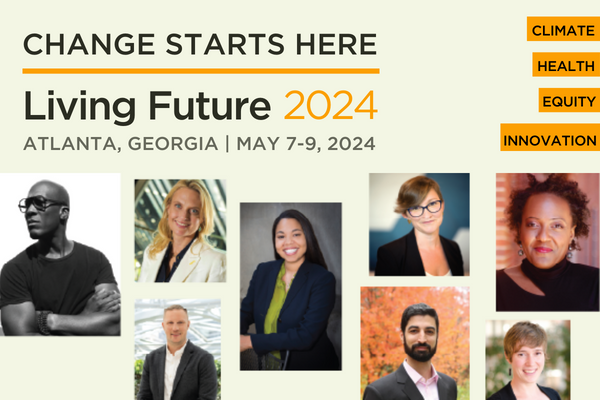The International Living Future’s annual conference meets in the Southeast for the first time, celebrating the Living Future community, the newest version of the Just program, and a book about the Stanley Center for Peace and Security.
April 24, 2024, Atlanta, GA – From May 7 through 9, the International Living Future Institute will host its 18th annual Living Future conference in Atlanta, marking the first time that the event has been held in the Southeast region of the US. “We are excited about this for many reasons,” says ILFI CEO Lindsay Baker. “There is great work going on in the Southeast,” she says. “There are lessons that we can learn from the communities who are realizing equity, health, and climate gains in the region.” The day before the conference, ILFI will host a materials summit with mindful Materials at which key stakeholders will share progress and next steps towards a future where regenerative materials, products, and environments are the norm.
The Living Future event has often tapped into cultural shifts and innovative practices. This year, the keynote lineup includes:
- Heather McTeer Toney is an attorney, environmentalist, speaker, and writer. She was the first Black, first female, and youngest mayor elected in Greenville, Mississippi, at age twenty-seven. In 2014, she was appointed by President Barack Obama as regional administrator for the Environmental Protection Agency’s Southeast Region.
- Marquise Stillwell, Founder of Openbox, is a designer and a catalyst for building communities and products across design, art, and culture. With a practice spanning across two decades, Marquise Stillwell’s journey began with a curiosity for people and spaces that later developed into a passion for designing systems that make all environments better for everyone.
- A Regenerative Revolution Panel will explore G.O.A.T. Living Buildings (some of the greatest, and largest). James Ball, Director of Buildings at Greenbiz, will moderate a conversation with Kate Turpin, Director, Design Performance + Real Estate Development at Google, Chris Roe, Director of Worldwide Environment + Carbon, Amazon, and Heather Henrikson, Chief Sustainability Officer at Harvard University. This is about setting new standards and redefining boundaries of scale and ambition in the realm of regenerative development.
Introducing Just 3.0
ILFI’s Just label program has been engaged by more than 350 organizations since its launch in 2014. Just® is an innovative social justice and equity label for all types and sizes of organizations. The program provides a simple, transparent framework for organizations to reveal much about their operations, including equitable treatment of employees and where they make financial and community investments. ILFI also transparently posts the detailed information in ILFI’s publicly viewable database. Early next month, following a rigorous development process with multiple stakeholders, ILFI debuts Just 3.0.
The evolution of the Just program has been driven by shifts in the global landscape, an enhanced comprehension of social justice issues, insights from technical advisors, and experiences of participating organizations. Since Just 2.0 launched in 2019, ILFI has identified gaps based on both new research and user experience feedback from Just organizations. This is also an opportunity to reframe the program to emphasize continuous improvement and the fact that growth is not always linear. Finally, a full program update provided the chance to reflect learning and progress around “what good looks like” based on ILFI’s current understanding of justice and equity in organizational contexts.
The Story of a Special Organization, Community, and Project
On May 7, ILFI’s publishing arm, Ecotone, releases its latest book, Healing Ground, Living Values: Stanley Center for Peace and Security, about the Muscatine, Iowa, adaptive reuse project whose owners are seeking Living Building Certification (at this writing, they have earned Ready Designation, the step before Final Audit on the path to certification). Author Justin R. Wolf tells the story of the organization; its community, Muscatine, Iowa; and its new headquarters. The project team included Neumann Monson Architects, Graham Construction, Design Engineers, Raker Rhodes Engineering, Biohabitats, Environmental Consulting & Technology, Integrated Eco Strategy, and others.
About the project, Lori Ferriss, architect, engineer, educator, and leader with Architecture 2030 and Climate Heritage Network, says: “This transformative project demonstrates that building reuse is not only a climate imperative, it is an opportunity to create spaces of delight, celebrate heritage, and regenerate ecosystems and neighborhoods, all while achieving the highest aspirations of environmental and social stewardship. It exemplifies that with enough creativity, a strong collective vision, and a dedication to doing the right thing, even the most unassuming existing building can become a beacon for a better future.”
###
ABOUT the International Living Future Institute
The International Living Future Institute’s mission is to cultivate a society that is socially just, culturally rich, and ecologically restorative. To do this, the organization envisions a Living Future and shows that it works better in practice and policy. The Institute is premised on the belief that providing a compelling vision for the future is needed to reconcile humanity’s relationship with the natural world. The Institute’s programs have shaped more than 55 million square feet of real estate development across the United States and around the world. Learn more at http://www.living-future.org.
ABOUT Healing Ground, Living Values
The eleventh publication in the Living Building Challenge Book Series, Healing Ground, Living Values details the story of the Stanley Center for Peace and Security, and of the enterprising people and city that helped make it what it is today. This book details how the Stanley Center organization and its design partners – beginning with Neumann Monson Architects – went about the arduous and unique challenge of adapting a 1970s-era public library building into a fully regenerative and accessible home for the nonprofit operating foundation. It further documents how the integrated project team approached various logistical and design challenges related to site ecology and hydrology, urban agriculture, embodied emissions, equity and inclusion, and other critical considerations en route to realizing this future Living Building in America’s heartland.
Media Contact:
Anjula Duggal
International Living Future Institute
anjula.duggal@living-future.org


